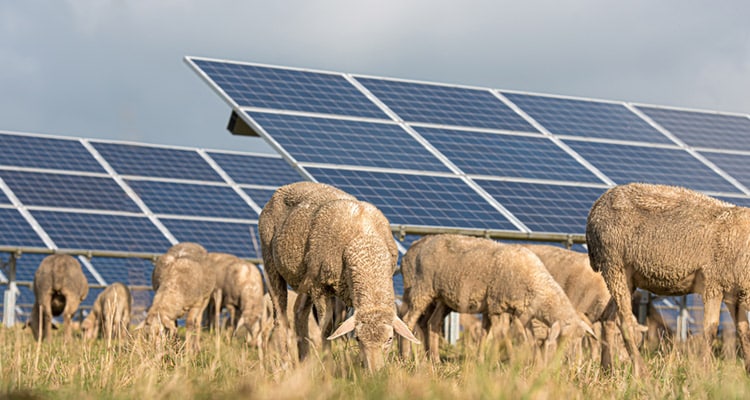Biodiversity photovoltaics: Is there an answer to the land dilemma?
Before parliament went on summer break, the German Federal Ministry for Economic Affairs and Climate Action (BMWK) wanted to make so-called biodiversity photovoltaics possible as part of the “Solar Package I” (Solarpaket I). This approach offers a promising double benefit by expanding the area available for solar parks and promoting biodiversity.
The land intended to be used is the four percent of agricultural land that farmers will have to take out of active farming from 2024 in order to continue to receive their EU land premium. Other land areas under the scope of eco-schemes will also be used. If the Federal Government implements the proposal, a considerable amount of land will be made available. According to WWF, for 100 percent renewable energy we need to use 2% of the total land area for wind and solar parks. Since about half of all land in Germany is agricultural, the land taken out of use alone covers the total land required for the energy transition.
In addition, the new revenue opportunities that can be created using land that is no longer actively farmed is economically beneficial to agricultural holdings. This is because the EU commitment to fallow seasons restricts opportunities for agricultural yield in the short term, even if they serve long-term yield-securing soil regeneration.
What exactly is meant by biodiversity photovoltaics?
This refers to solar parks where solar power is generated but where the land is also used for extensive farming. Biodiversity photovoltaics is a comprehensive form of agrivoltaics. Compared to agrivoltaics, installed at a high elevation, the construction of the biodiversity-promoting solar parks is much simpler. The BMWK is planning to establish a uniform definition for biodiversity photovoltaics, which is to be promoted via the EEG, Germany’s renewable energy law. According to the Ministry’s plans, no compensation areas are to be made mandatory for biodiversity PV systems.
The Association of Energy Market Innovators (BNE) has defined in the form of a legal report how biodiversity photovoltaics can be implemented in concrete terms. The report includes legislative proposals on how biodiversity photovoltaics could be established in the EEG and agricultural law. According to the BNE, in the case of biodiversity photovoltaics, the row spacing would have to be extended to at least 3.5 to 4m, which is important for homogeneous water distribution. Extensive farming refers to seasonal grazing or mechanical cultivation, which is carried out using less invasive techniques (e.g. double knife mowing technology, no mulching). Depending on the cultivation concept, the cuttings would have to be removed. According to the legal report, at least four regional identification types would need to be detectable on the land or the requirements for non-productive land areas would need to be complied with.
Evidently, however, biodiversity photovoltaics did not make it into “Solar Package I” (Solarpaket I), as they are not included in the draft bill of “a law to increase the expansion of photovoltaic energy generation”. It remains to be seen whether improvements will be made here or whether biodiversity photovoltaics will find a place in the planned “Solar Package II”.
This would make sense, since species protection is of great importance: biodiversity, like the climate, is in a huge crisis, and both are in need of serious solutions. More than 10% of species in Europe are threatened with extinction.
Do biodiversity photovoltaics really protect biodiversity?
If biodiversity photovoltaics are indeed brought in by the Federal Government, intensively used arable and grassland would be converted into extensively used permanent grassland. According to the Federal Agency for Nature Conservation (BFN), 40% of all fern and flowering plants endangered in Germany are found on grassland. However, if the BMWK fails with its proposal, all of the areas mentioned will become fallow land.
The crucial question therefore is whether it is fallow land or extensively farmed permanent grassland that is better for biodiversity. In my opinion, this question cannot be answered with blanket statements because it depends on what happened on the land before and what types of land are in the area. If, for example, corridors between habitats are created with the area, then permanent cultivation as extensive grassland would be preferable.
The most important comparison factor, however, is time. A one-year break as a fallow land is already sufficient to comply with EU rules. Breaks of less than five years are common for fallow land. But with biodiversity photovoltaics, there would be breaks in use of more than 20 years.
In simple terms, extensive permanent grassland protects biodiversity better than short fallow periods. Long-standing fallow land and permanent grassland are both ecologically valuable for many different species. Long-term breaks in use and permanent land are important for soil and water protection.
How biodiverse are normal solar parks?
Even without biodiversity photovoltaics, solar parks are, in most cases, beneficial to biodiversity as they can offer helpful “stepping stones” for rare flora and fauna in the agricultural landscape. This is shown both by investigations by the Association of Energy Market Innovators (BNE) and the accompanying investigations by university TH Bingen, which were used to derive the practical instructions for nature-friendly and biodiversity-promoting solar parks. How land was previously used is always decisive for how much biodiversity can be increased. In particular, compared to a formerly intensively farmed field, a normal solar park offers a habitat for significantly more species.
The Federal Agency for Nature Conservation states that, among other things, the following effects should be considered as risks to biodiversity from open-air solar installations:
- Impairment and alteration of the natural soil profile
- Compaction of soil areas through the movement and storage of building materials
- Impairment, alteration and destruction of the habitats of existing species of flora and fauna as well as a fragmentation of migratory corridors
- Modification of the water regime and soil water balance due to the module superstructure
The authors of the study by TH Bingen, University of Applied Sciences, are calling for additional measures for biodiversity that go beyond the effects of normal solar parks. They make a distinction between mandatory nature conservation obligations, such as intervention regulations and compensation requirements, as well as protection requirements and other voluntary measures. According to the study, added value for nature will only arise with the use of additional measures.
How can solar parks still contribute to biodiversity?
Even without biodiversity photovoltaics, operators of existing solar parks and project planners can design their solar parks during the planning phase in a nature-friendly way. A guideline from TH Bingen provides concrete practical advice for this. In addition, more and more project planners are signing the “Good Planning” (Gute Planung) voluntary commitment, which includes an increase in biodiversity.
In planning, an added value for biodiversity, among other things, can be created by maintaining larger row distances (> 3.5m, but ideally 5m), sealing as few areas as possible, installing fences 15 – 20 cm above the ground, for large systems (from about 500m) keeping migratory corridors for large animals free or leaving space for flowering strips or hedges.
Have a concept for conservation created
Conservation and care adapted to the site and ecologically oriented is decisive for the natural compatibility of an area. Specialised planners can also develop so-called “target biotopes” for existing plants and derive differentiated conservation management from them. You can learn what should be sown or planted, how the land should be kept ecologically open, whether topsoil should be built up or the soil hauled away, and much more.
Of course, there is greater opportunity for this when planning a PV plant. Local natural conservation can also be involved in this process. Highly exemplary solar parks could even play a role in public relations with sponsorships (e.g. via conservation and environmentalist associations).
Maintaining areas: mowing or grazing?
The land must always be kept clear to prevent shadows from growing over the PV modules, reducing yield. In order for this land to grow into a species-rich grassland, different forms of extensive cultivation or maintenance can be adapted to the site and the PV plant. This means first and foremost that neither poisons nor fertilisers are used.
If the area is to be mowed, mowing technique plays a role: TH Bingen recommends sickle bar mowers with a minimum height of 10 cm. When mowing should occur and how frequently (or ideally, infrequently) can also be determined from a conservationist point of view, taking into account the operator’s needs. Unfortunately, with PV modules installed close to the ground, mowing must be done more often. If a previously fertilised field is to be harvested, the mown cuttings will need to be removed. Mowing can also be organised in an alternating pattern, leaving suitable portions of the land unmowed each year to offer forage, habitat, and refuges in winter.
Even better for biodiversity is grazing using sheep or goats. Successive grazing ensures that flora is always present in sufficient numbers. The animals’ claws also open up the soil, where less-competing species can germinate, or wild bees can settle in. It is important for grazing that there are no flat bars protruding from the modules and that sharp edges are removed and free-hanging cables avoided. Likewise, the inverters and plugs should be protected, as animals like to rub against them. The minimum height of the lower edge of the solar modules should usually be 80 cm (as is already the case with many installations), so that sheep can walk underneath and do not become restless being separated from each other.
Creating a biotope
The seed or planting material should be as native to the area as is possible. For a cost-effective method, the seeds can also be introduced via hay coming from neighbouring grassland. Depending on the location, additional biotopes can also be created:
- Dry biotopes such as sand, rubblestone, or dead wood piles.
- Wetland biotopes such as ponds and pools at the edges of a solar plant. These can be fed by rainwater running off from the module structures.
- Nesting supports for birds, bats, and wild bees.
Click here for the guide to nature-compatible and biodiversity-friendly solar parks from TH Bingen (in German).
“Good planning” commitment
The german solar industry has recognised the opportunity to make a contribution to biodiversity, as well as environmental protection. Ever more photovoltaic enterprises are signing the voluntary commitment from the Association of Energy Market Innovators (BNE). Learn more about the voluntary commitment for good planning of ground-mounted photovoltaic systems here on the blog. As well as increasing biodiversity, the voluntary commitment includes obligations to communities, administrations, citizens, fair business with farmers, and the integration of photovoltaic systems into the landscape.
What does biodiversity mean for investors?
The advantage of biodiversity photovoltaics over individual actions or self-commitment lies in its broad effectiveness. The likely simple implementation of the requirements for biodiversity photovoltaics contributes to this. For investors with a focus on impact, PV projects with added value beyond this can be attractive for biodiversity. Biodiversity in solar parks can be well documented with photos and facts.
While some environmental benefits are achieved while saving on costs, others require more space. To some extent, this comes at the expense of yields or increased leasing and maintenance costs. Investing in a specialist planner at the start of a project is helpful. Potential compensation can be organised so that it is provided directly on-site. Moreover, the question is one of prioritisation. In addition to financial return, the demonstrable ecological return can be perceived as attractive. Biodiversity, but also additional biotopes and the involvement of natural conservation can also increase the acceptance of PV projects by locals.





